Workshop: Chinese Floral Ink Painting on Rice Paper
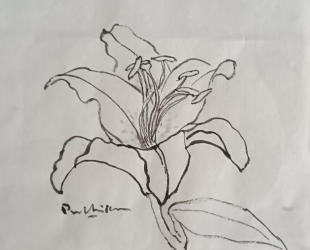
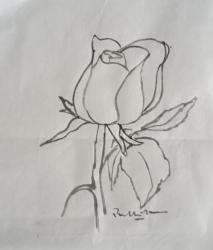
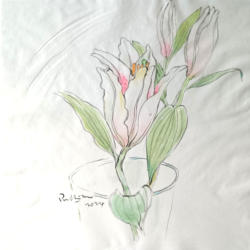
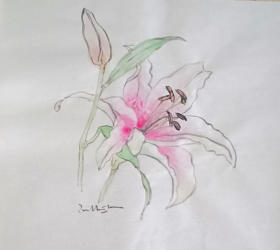
The above paintings reflect traditional Chinese painting techniques,
focusing on delicate line work and washes of subtle colour. For this
Chinese painting workshop, we will structure four lessons to gradually
develop skills in Chinese ink painting. Here's a breakdown:
Lesson 1: Introduction to Tools and Basic Strokes
Objective: Familiarize students with the essential tools of Chinese ink
painting (rice paper, ink, brushes) and practice fundamental
brushstrokes.
•
Materials Needed:
•
Rice paper (Xuan paper)
•
Chinese ink (bottled or ink stick)
•
Calligraphy/painting brushes (different sizes)
•
Water and inkstone
•
Lesson Plan:
1.
Introduction to Tools: Explanation of how to prepare rice paper,
ink, and use of different types of brushes.
2.
Basic Brush Techniques: Introduce basic strokes (e.g., dot,
horizontal, vertical, angled) using minimal pressure and different
parts of the brush.
Practice drawing simple lines and shapes to understand the control
of ink flow and brush pressure.
3.
Painting Exercises: Have students create simple shapes, such as
bamboo leaves or plum blossoms, focusing on ink consistency and
line quality.
Lesson 2: Painting Rosebuds (Monochrome Study)
Objective: Teach students how to paint a rosebud in monochrome
using varying ink tones and brush techniques.
•
Materials Needed:
•
Same as Lesson 1
•
Reference sketch of a rosebud (like the first image)
Lesson Plan:
1.
Exploring Tonal Values: Demonstrate how to achieve light,
medium, and dark tones using diluted ink.
2.
Sketching the Rosebud: Start with a simple line drawing of a
rosebud. Teach how to capture the shape and essence using light,
flowing strokes.
3.
Building Depth with Ink Washes: Guide students on how to apply
washes for shading, creating depth and volume in the petals and
leaves.
4.
Final Touches: Add fine details like stems, thorns, and leaves using
darker, more defined strokes.
Lesson 3: Flower Composition with Colour
Objective: Introduce colour into Chinese ink painting, focusing on the
lily flower and blending colour with ink.
•
Materials Needed:
•
Chinese watercolours or pigments
•
Soft brushes for colour blending
•
Reference sketch of lilies (like your second image)
•
Lesson Plan:
1.
Introduction to Colour in Chinese Painting: Discuss the minimal
and soft use of colour in traditional painting, with an emphasis on
restraint.
2.
Sketching Lilies: Have students sketch out a simple lily
composition on rice paper.
3.
Adding Colour to Ink: Demonstrate how to mix watercolours with
ink to create soft shades for the petals. Focus on gentle transitions
from light to dark within each petal.
4.
Final Detailing: Add details like stamens and leaves, allowing
students to experiment with combining both colour and
monochrome ink.
Lesson 4: Advanced Floral Study and Individual Projects
Objective: Encourage students to work on a full floral composition,
combining monochrome and colour techniques.
•
Materials Needed:
•
Full range of brushes, inks, and colours
•
Student’s preferred flower or their own composition ideas
•
Lesson Plan:
1.
Review of Techniques: Begin with a quick review of ink and colour
techniques learned in the previous classes.
2.
Composing a Floral Painting: Guide students in creating a more
complex floral composition, encouraging them to combine several
flowers, leaves, or branches in a single painting.
3.
Individual Project Time: Allow students to choose their own
flowers or compositions, incorporating all the techniques they've
learned (line drawing, ink shading, colour addition).
4.
Group Critique and Feedback: End the class with a discussion
where students share their work and receive constructive feedback.
Outcomes:
By the end of this four-lesson workshop, students will:
•
Understand how to use Chinese ink and watercolours on rice paper.
•
Be able to paint floral compositions with a focus on rosebuds, lilies,
and other flowers.
•
Have developed skills in brush control, ink washes, and colour
blending techniques.
This gradual approach helps students grow from basic strokes to more
complex and expressive floral studies while maintaining the elegance
and simplicity of traditional Chinese painting.
Link:
Chinese Painting Workshop for Beginners


Workshop: Chinese Floral Ink
Painting on Rice Paper
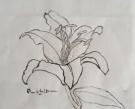


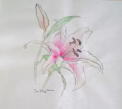
The above paintings reflect traditional Chinese
painting techniques, focusing on delicate line work
and washes of subtle colour. For this Chinese
painting workshop, we will structure four lessons to
gradually develop skills in Chinese ink painting.
Here's a breakdown:
Lesson 1: Introduction to Tools and Basic
Strokes
Objective: Familiarize students with the essential
tools of Chinese ink painting (rice paper, ink,
brushes) and practice fundamental brushstrokes.
•
Materials Needed:
•
Rice paper (Xuan paper)
•
Chinese ink (bottled or ink stick)
•
Calligraphy/painting brushes (different sizes)
•
Water and inkstone
•
Lesson Plan:
1.
Introduction to Tools: Explanation of how to
prepare rice paper, ink, and use of different
types of brushes.
2.
Basic Brush Techniques: Introduce basic
strokes (e.g., dot, horizontal, vertical, angled)
using minimal pressure and different parts of
the brush.
Practice drawing simple lines and shapes to
understand the control of ink flow and brush
pressure.
3.
Painting Exercises: Have students create
simple shapes, such as bamboo leaves or plum
blossoms, focusing on ink consistency and line
quality.
Lesson 2: Painting Rosebuds (Monochrome
Study)
Objective: Teach students how to paint a rosebud
in monochrome using varying ink tones and brush
techniques.
•
Materials Needed:
•
Same as Lesson 1
•
Reference sketch of a rosebud (like the first
image)
Lesson Plan:
1.
Exploring Tonal Values: Demonstrate how to
achieve light, medium, and dark tones using
diluted ink.
2.
Sketching the Rosebud: Start with a simple
line drawing of a rosebud. Teach how to
capture the shape and essence using light,
flowing strokes.
3.
Building Depth with Ink Washes: Guide
students on how to apply washes for shading,
creating depth and volume in the petals and
leaves.
4.
Final Touches: Add fine details like stems,
thorns, and leaves using darker, more defined
strokes.
Lesson 3: Flower Composition with Colour
Objective: Introduce colour into Chinese ink
painting, focusing on the lily flower and blending
colour with ink.
•
Materials Needed:
•
Chinese watercolours or pigments
•
Soft brushes for colour blending
•
Reference sketch of lilies (like your second
image)
•
Lesson Plan:
1.
Introduction to Colour in Chinese Painting:
Discuss the minimal and soft use of colour in
traditional painting, with an emphasis on
restraint.
2.
Sketching Lilies: Have students sketch out a
simple lily composition on rice paper.
3.
Adding Colour to Ink: Demonstrate how to
mix watercolours with ink to create soft shades
for the petals. Focus on gentle transitions from
light to dark within each petal.
4.
Final Detailing: Add details like stamens and
leaves, allowing students to experiment with
combining both colour and monochrome ink.
Lesson 4: Advanced Floral Study and
Individual Projects
Objective: Encourage students to work on a full
floral composition, combining monochrome and
colour techniques.
•
Materials Needed:
•
Full range of brushes, inks, and colours
•
Student’s preferred flower or their own
composition ideas
•
Lesson Plan:
1.
Review of Techniques: Begin with a quick
review of ink and colour techniques learned in
the previous classes.
2.
Composing a Floral Painting: Guide students
in creating a more complex floral composition,
encouraging them to combine several flowers,
leaves, or branches in a single painting.
3.
Individual Project Time: Allow students to
choose their own flowers or compositions,
incorporating all the techniques they've
learned (line drawing, ink shading, colour
addition).
4.
Group Critique and Feedback: End the class
with a discussion where students share their
work and receive constructive feedback.
Outcomes:
By the end of this four-lesson workshop, students
will:
•
Understand how to use Chinese ink and
watercolours on rice paper.
•
Be able to paint floral compositions with a focus
on rosebuds, lilies, and other flowers.
•
Have developed skills in brush control, ink
washes, and colour blending techniques.
This gradual approach helps students grow from
basic strokes to more complex and expressive floral
studies while maintaining the elegance and
simplicity of traditional Chinese painting.
Link:
Chinese Painting Workshop for Beginners



















